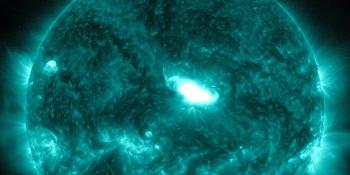Indeks Ap
The Ap-index provides a daily average level for geomagnetic activity. Because of the non-linear relationship of the K-scale to magnetometer fluctuations, it is not meaningful to take the average of a set of K-indices. Instead, every 3-hour K-value will be converted back into a linear scale called the a-index. The average from 8 daily a-values gives us the Ap-index of a certain day. The Ap-index is thus a geomagnetic activity index where days with high levels of geomagnetic activity have a higher daily Ap-value.
How do you determine the Ap-index?
The daily Ap-value is obtained by averaging the eight 3-hour values of ap for each day. To get the Ap-value you first need to convert the 3-hour Kp-values to ap-values. Be aware that we use the official, finalized Kp which comes from the GFZ in Potsdam, Germany. This Kp-index works slightly different then the preliminary Kp-index. Read about this in our Kp-index help article. To make it a bit more clear on how you can determine the Ap for a certain day, we will work with an example: we take one day with the following measured Kp-values: 0+, 2-, 2o, 3o, 7-, 8o, 9- and 9o. The next step would be to convert these Kp-values to ap-values. The table at the bottom of this article will help you with this. When we are done converting we get these eight ap-values: 2, 6, 7, 15, 111, 207, 300 and 400. The average of these eight values will give you the Ap for that day. The day that we used in this example day would have an Ap-value of 131. The table below will let you convert the Kp-values to ap-values.
| indeks kp | Kp in decimals | ap | Skala G |
|---|---|---|---|
| 0o | 0,00 | 0 | G0 |
| 0+ | 0,33 | 2 | G0 |
| 1- | 0,67 | 3 | G0 |
| 1o | 1,00 | 4 | G0 |
| 1+ | 1,33 | 5 | G0 |
| 2- | 1,67 | 6 | G0 |
| 2o | 2,00 | 7 | G0 |
| 2+ | 2,33 | 9 | G0 |
| 3- | 2,67 | 12 | G0 |
| 3o | 3,00 | 15 | G0 |
| 3+ | 3,33 | 18 | G0 |
| 4- | 3,67 | 22 | G0 |
| 4o | 4,00 | 27 | G0 |
| 4+ | 4,33 | 32 | G0 |
| 5- | 4,67 | 39 | G1 |
| 5o | 5,00 | 48 | G1 |
| 5+ | 5,33 | 56 | G1 |
| 6- | 5,67 | 67 | G2 |
| 6o | 6,00 | 80 | G2 |
| 6+ | 6,33 | 94 | G2 |
| 7- | 6,67 | 111 | G3 |
| 7o | 7,00 | 132 | G3 |
| 7+ | 7,33 | 154 | G3 |
| 8- | 7,67 | 179 | G4 |
| 8o | 8,00 | 207 | G4 |
| 8+ | 8,33 | 236 | G4 |
| 9- | 8,67 | 300 | G4 |
| 9o | 9,00 | 400 | G5 |
Najnowsze wiadomości
Najnowsze wiadomości z forum
Wesprzyj SpaceWeatherLive.com!
Wielu ludzi odwiedza SpaceWeatherLive aby śledzić aktywność słoneczną lub sprawdzić czy jest szansa na zaobserwowanie zorzy polarnej. Niestety, większy ruch na stronie oznacza większe koszty utrzymania serwera. Dlatego, jeśli jesteś zadowolony ze strony SpaceWeatherLive, zachęcamy do wspierania nas finansowo. Dzięki temu będziemy mogli utrzymać naszą stronę.

Fakty na temat pogody kosmicznej
| Ostatnie rozbłyski klasy X | 2024/11/06 | X2.39 |
| Ostatnie rozbłyski klasy M | 2024/11/13 | M1.7 |
| Ostatnia burza geomagnetyczna | 2024/11/10 | Kp5+ (G1) |
| Dni bez plam słonecznych | |
|---|---|
| Ostatni dzień bez skazy | 2022/06/08 |
| Średnia miesięczna liczba plam słonecznych | |
|---|---|
| października 2024 | 166.4 +25 |
| listopada 2024 | 170.8 +4.3 |
| Ostatnie 30 dni | 165.1 +20.3 |


